

Odysee.com. Yuunarii on odysee.com. Build your own kaleidoscope. RPG Personality Test. Learning Binary with Touhou Elements Part 1 by HTFCirno2000 on deviantART. Grid Paper PDFs. Free Online Graph Paper / Grid Paper PDFs Downloadable and very printable, I find these PDFs extremely useful.

Tip number one! Though I do return the correct header for a PDF, sometimes Explorer gets confused when downloading... So if you're running Windows, you may need to right-click a link and choose "Save link to disk". Tip number two! Some people may need to turn off the option in Adobe's Acrobat reader "shrink to fit" which may resize the grid slightly to fit your printer's printable area. Tip number three! If you want the hexes aligned with the other edge of the paper, just make your paper size "11 x 8.5" and print the result in landscape mode! Aromatherapy and Essential Oils. Skill Showcase - Kuma Films. NUSensei - Archery. Fediverse tutorials. Thesaurus and Word Tools.
The PARA Method: A Universal System for Organizing Digital Information - Forte Labs. This article is also available in Dutch Imagine for a moment the perfect organizational system.

One that supported and enhanced the work you do, telling you exactly where to put a piece of information, and exactly where to find it when you needed it. This system would have to be: I believe I’ve developed a system for organizing digital information that meets all these requirements. After several years of introducing it to a wide variety of people, I’m confident that it works. P.A.R.A. stands for Projects — Areas — Resources — Archives, the four top-level categories that encompass every type of information you might encounter in your work and life.
Let’s start with definitions. A project is “a series of tasks linked to a goal, with a deadline.” Examples include: Complete app mockup; Develop project plan; Execute business development campaign; Write blog post; Finalize product specifications; Attend conference A resource is “a topic or theme of ongoing interest.” Projects vs. Making Lists. This Expanding Mechanism is Crazy Clever. The Machine That Erases What It Creates. Greatest Optical Illusions Pictures. OK, this one really belongs in the Skytopia 3D stereoscopic gallery, but I just couldn't resist.

Advanced Ancient Machining That Is Absurdly Difficult To Replicate Even With Today's Technology. Cairo Museum "Out Of Place Artifacts." More Evidence Of Ancient Advanced Technology. Pareto principle. The Pareto Principle asserts that only a "vital few" peapods produce the majority of peas.
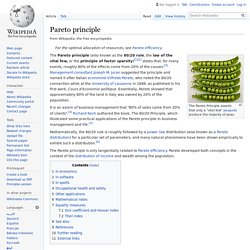
The Pareto principle (also known as the 80/20 rule, the law of the vital few, or the principle of factor sparsity)[1][2] states that, for many events, roughly 80% of the effects come from 20% of the causes.[3] Management consultant Joseph M. Juran suggested the principle and named it after Italian economist Vilfredo Pareto, who noted the 80/20 connection while at the University of Lausanne in 1896, as published in his first work, Cours d'économie politique. Essentially, Pareto showed that approximately 80% of the land in Italy was owned by 20% of the population. It is an axiom of business management that "80% of sales come from 20% of clients".[4] Richard Koch authored the book, The 80/20 Principle, which illustrated some practical applications of the Pareto principle in business management and life.[5]
A Japanese Master Craftsman Taught Me To Make Senko Hanabi Fireworks. How To Make Lampblack (Ancient Ink & Rare Firework Ingredient) Tao Te Ching. Shang Pian[edit] Chapter 1 (第一章)[edit] Chapter 2 (第二章)[edit] Chapter 3 (第三章)[edit] Chapter 4 (第四章)[edit] Chapter 5 (第五章)[edit] Note: Chugou (芻狗, literally "grass dog") is a straw-made dog-shaped sacrifice used in ancient China.
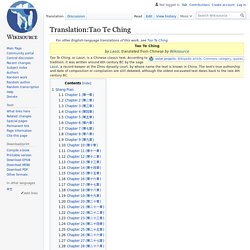
Chapter 6 (第六章)[edit] Chapter 7 (第七章)[edit] Chapter 8 (第八章)[edit] Chapter 9 (第九章)[edit] Hidden Dice Faces - Numberphile. Animeast Wallpapers. Anime Galleries. Shimeji English Enhanced. Shimeji is a Windows desktop mascot that freely wanders and plays around the screen.
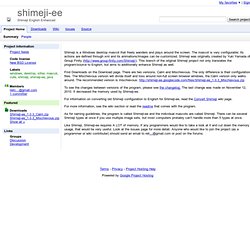
The mascot is very configurable; its actions are defined through xml and its animations/images can be customized. Shimeji was originally created by Yuki Yamada of Group Finity ( This branch of the original Shimeji project not only translates the program/source to English, but aims to additionally enhance Shimeji as well. Find Downloads on the Download page. There are two versions, Calm and Mischievous. The only difference is their configuration files. To see the changes between versions of the program, please see the changelog. Lyrics. Anime Lyrics dot Com - Misty Chronexia - Anime. Chinese Four Pillars of Destiny (Ba Zi) Calculator. The year of your birth (with its corresponding animal sign) represents only the most general of characteristics - i.e., those which may be shared with everyone who happens to be born in that year.
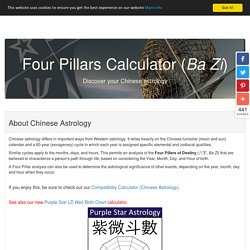
A much more detailed personal analysis is provided by exploring all Four Pillars, taking into account not only the year, but also the month, day, and hour of birth. Each of the pillars is made up of two characters: (1) a Heavenly Stem, representing the quality of elemental force, and (2) an Earthly Branch, representing the way this is expressed. There are ten Heavenly Stems, each combining one of the five classical Chinese elements with either positive (Yang) or negative (Yin) energy.
Four Pillars and Feng Shui Calculator Gadgets for your site. 4P Charting. Cycle - Ganzhi App. Sexagenary cycle. Historical method for reckoning time in China The sexagenary cycle, also known as the Stems-and-Branches or ganzhi (Chinese: 干支), is a cycle of sixty terms, each corresponding to one year, thus a total of sixty years for one cycle, historically used for recording time in China and the rest of the East Asian cultural sphere.[1] It appears as a means of recording days in the first Chinese written texts, the Shang oracle bones of the late second millennium BC.
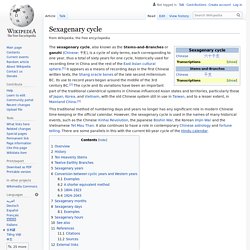
Its use to record years began around the middle of the 3rd century BC. The cycle and its variations have been an important part of the traditional calendrical systems in Chinese-influenced Asian states and territories, particularly those of Japan, Korea, and Vietnam, with the old Chinese system still in use in Taiwan, and to a lesser extent, in Mainland China.[3] This traditional method of numbering days and years no longer has any significant role in modern Chinese time-keeping or the official calendar. Overview[edit] History[edit] Astrology: Greenwich Mean Time GMT. While few people are actually going to work out astrological charts by hand, that is, using paper, pencil, it is, I believe, important to know how to do it.

It may also be true, that unless an astrologer spends a great deal of time doing charts by hand, they will never fully understand astrology. By doing charts by hand, you will begin to understand more about the movement of the planets and how they combine to affect the lives of people on Earth.. Another reason is that astrology is a sacred science and by doing the mundane routine things, our minds enter a meditative state wherein we realise things we might not have been able to know or understand otherwise. The tools you require to make a horoscope are (in addition to writing and drawing tools) are an atlas and an ephemeris. The Correct Way of Calculating the Hour of Birth in Four Pillars of Destiny - Ancient and Chinese Astrology.
This article is about correctly calculating the hour of birth in Four Pillars of Destiny.
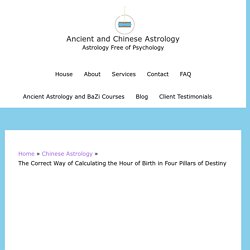
Please read it carefully. You may know your time of birth to the minute and the BaZi astrologer can calculate your Hour Pillar incorrectly, which will actually change your chart. This is because there are several ways of calculating the hour of birth in BaZi. ESRL Global Monitoring Laboratory - Global Radiation and Aerosols.
Find Sunrise, Sunset, Solar Noon and Solar Position for Any Place on Earth Move the large red pin to the desired location and enter the date and time at which to calculate the sun position. Leaflet | Powered by Esri | Esri, HERE, Garmin, NGA, USGS Location: Working... Date: Home - Four Pillars & Feng Shui. How To Read A BaZi Chart: The Right & Holistic Way. Chinese Astrology for Beginners. BaZi Insider + Yi Ming 易命 Medicine. Lewis Howes. Clark Kegley. Stephan Speaks.